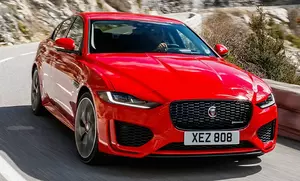
| Vehicle | Precise engine size | Difference from world average | Engine size to consumption ratio | Horsepower from 1 L | Engine size to 100 kg of weight |
|---|---|---|---|---|---|
| D180 |
2 L (1999 cc) |
14.8% smaller | 44 cc to 1 mpg | 90 hp from 1 L | 125 cc to 100 kg |
| P250 |
2 L (1997 cc) |
14.9% smaller | - | 125 hp from 1 L | 125 cc to 100 kg |
| P300 |
2 L (1997 cc) |
14.9% smaller | 62 cc to 1 mpg | 150 hp from 1 L | 125 cc to 100 kg |
| Vehicle | D180 |
|---|---|
| Precise engine size | 2 L (1999 cc) |
| Difference from world average | 14.8 smaller |
| Engine size to consumption ratio | 44 cc to 1 mpg |
| Horsepower from 1 L | 90 hp from 1 L |
| Engine size to 100 kg of weight | 125 cc to 100 kg |
| Vehicle | P250 |
| Precise engine size | 2 L (1997 cc) |
| Difference from world average | 14.9 smaller |
| Engine size to consumption ratio | - |
| Horsepower from 1 L | 125 hp from 1 L |
| Engine size to 100 kg of weight | 125 cc to 100 kg |
| Vehicle | P300 |
| Precise engine size | 2 L (1997 cc) |
| Difference from world average | 14.9 smaller |
| Engine size to consumption ratio | 62 cc to 1 mpg |
| Horsepower from 1 L | 150 hp from 1 L |
| Engine size to 100 kg of weight | 125 cc to 100 kg |

| Vehicle | Precise engine size | Difference from world average | Engine size to consumption ratio | Horsepower from 1 L | Engine size to 100 kg of weight |
|---|---|---|---|---|---|
| 2.0d |
2 L (1999 cc) |
14.8% smaller | 44 cc to 1 mpg | 120 hp from 1 L | 118 cc to 100 kg |
| 2.0 |
2 L (1997 cc) |
14.9% smaller | 59 cc to 1 mpg | 150 hp from 1 L | 125 cc to 100 kg |
| 3.0 V6 |
3 L (2995 cc) |
27.7% bigger | 103 cc to 1 mpg | 113 hp from 1 L | 176 cc to 100 kg |
| S 3.0 |
3 L (2995 cc) |
27.7% bigger | 103 cc to 1 mpg | 127 hp from 1 L | 176 cc to 100 kg |
| SV Project 8 5.0 V8 |
5 L (5000 cc) |
113.1% bigger | - | 120 hp from 1 L | 294 cc to 100 kg |
| Vehicle | 2.0d |
|---|---|
| Precise engine size | 2 L (1999 cc) |
| Difference from world average | 14.8 smaller |
| Engine size to consumption ratio | 44 cc to 1 mpg |
| Horsepower from 1 L | 120 hp from 1 L |
| Engine size to 100 kg of weight | 118 cc to 100 kg |
| Vehicle | 2.0 |
| Precise engine size | 2 L (1997 cc) |
| Difference from world average | 14.9 smaller |
| Engine size to consumption ratio | 59 cc to 1 mpg |
| Horsepower from 1 L | 150 hp from 1 L |
| Engine size to 100 kg of weight | 125 cc to 100 kg |
| Vehicle | 3.0 V6 |
| Precise engine size | 3 L (2995 cc) |
| Difference from world average | 27.7 bigger |
| Engine size to consumption ratio | 103 cc to 1 mpg |
| Horsepower from 1 L | 113 hp from 1 L |
| Engine size to 100 kg of weight | 176 cc to 100 kg |
| Vehicle | S 3.0 |
| Precise engine size | 3 L (2995 cc) |
| Difference from world average | 27.7 bigger |
| Engine size to consumption ratio | 103 cc to 1 mpg |
| Horsepower from 1 L | 127 hp from 1 L |
| Engine size to 100 kg of weight | 176 cc to 100 kg |
| Vehicle | SV Project 8 5.0 V8 |
| Precise engine size | 5 L (5000 cc) |
| Difference from world average | 113.1 bigger |
| Engine size to consumption ratio | - |
| Horsepower from 1 L | 120 hp from 1 L |
| Engine size to 100 kg of weight | 294 cc to 100 kg |